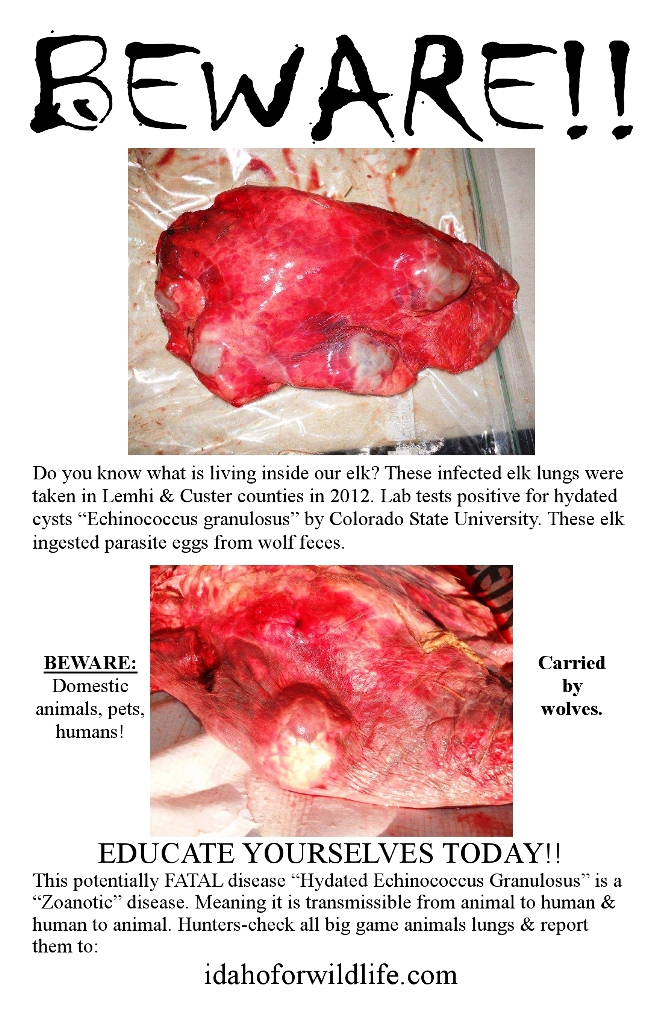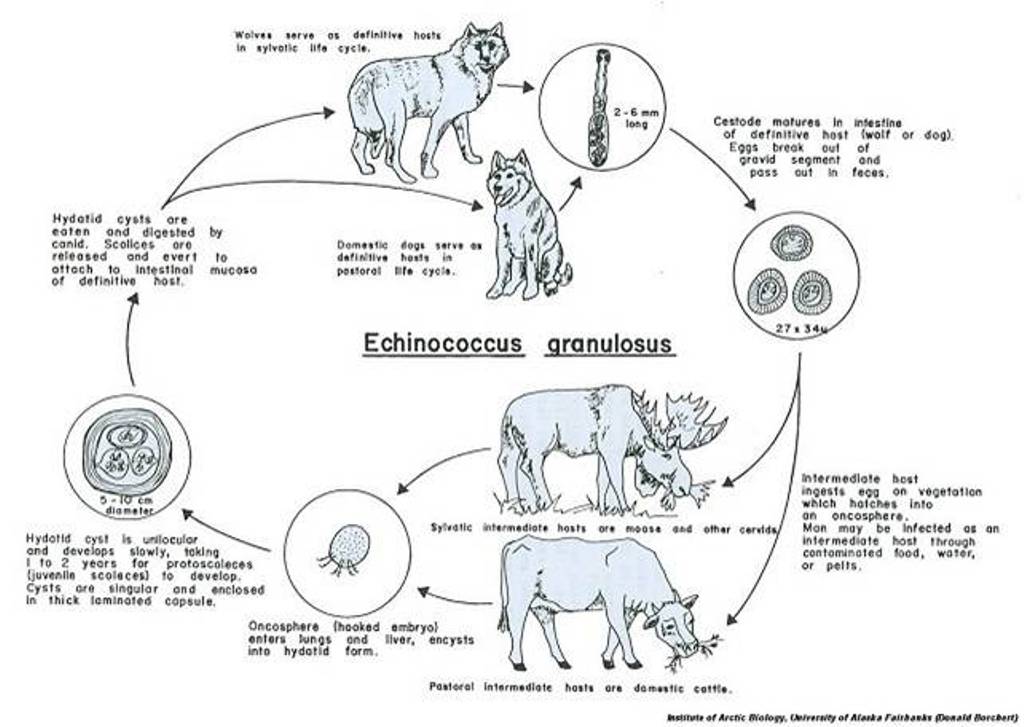Wolf Diseases
Dr. Charles Kay not only explains the seriousness of wolves spreading diseases but how wolves increase disease transmission with our elk due to the "landscape of fear"
12-2017 Wolf Tapeworms: What does it mean for hunters and trappers?
1-22-2018 From Wiley.com, "Recolonizing gray wolves increase parasite infection risk in their prey."
12-6-2017 Saskatoon veterinarian says "there's a very good chance" Saskatchewan could see human cases of a potentially lethal tapeworm in the foreseeable future.
4-10-17 Jim Beers on wolf diseases and reforming the ESA
Cattle abortions: Wolves are definitive hosts of Neospora caninum which is a major cause of abortions in cattle. How to recognize and prevent this costly wolf spread disease.
As far back as 2006, lab results indicated that 66% of examined Idaho Wolf Carcasses were full of thousands of Hydatid Disease Tapeworms!
This is a must see Video! - Cystic echinococcosis - Kist hidatik (subtitle in English)
6-16-2012-Science Blogs spotlight on Nasty Parasites: Echinococcus Granulosus:
5-9-2011- Letter to Boone and Crocket club from Dr. Val Geist on hydatid diseases
11-26-2010 The myth of the harmless wolf, Dr. Valerius Geist
7-31-2010: Dr. Valerious Geist's letter to Steve Alder regarding the dangers of hydatid diseases
1-2010: Jim Beers Interview with Will Graves regarding hydatid diseases
Is this what we want our kids to experience while hunting??????? (Click here)
10-2009 Study claims this is the first report of Echinococcus granulosus in Idaho
The hydatid disease issue is serious, however, one does need to know matters precisely. While hydatid cysts in a bull elk's lungs are not pretty, they do not affect the edibility of the meat. The meat of a deer, elk or moose infected with hydatid cysts is safe to eat, and should not be thrown away. Even if you find a cyst in the elk's liver, cut out the cysts, and slice up the liver, put it into a hot pan with butter and - enjoy it. I would! You worked hard enough to get the elk and you can in good conscience make use of it.
However, and this needs to be spread far and wide, if you find cysts in the lungs, or in then liver and you do not want the liver, make a fire and burn liver and lungs to break the hydatid cycle. We hunters need now a new ethics in handling game; DESTROY TISSUE CONTAINING CYSTS. DO NOT LEAVE GUT PILES WITH CYSTS FOR COYOTES AND WOLVES TO FEED ON!
Also, gut piles with hydatid cysts in lung and liver are a danger to hunters hunting with dogs. Dogs will feed on such piles if they find them in the course of hunting, and may become infected with the dog tapeworm. The dog will then defaecate infected feces within seven weeks, a deadly danger to the community the dog is in. I see no alternative, but purge the dogs regularly and frequently for tape worms. Vets need to be sensitized to this.
As to dangers from air born Echinococcus eggs on trails: much of the danger can be reduced by getting into the habit of deliberately and consciously washing hands before cooking or eating.
Your fish and wildlife biologists should be telling you this!
As I have said before, wolves have no place in a settled landscapes for a number of reasons and should be removed by professional predator control officers when they do show up.
Sincerely,
Val Geist




Recently “Wolves in Russia” author Will Graves has been communicating with a professor of Veterinary Epidemiology in Kazakhstan regarding wolf diseases, (See below) and uncovered some potential threats we must be prepared for here in Idaho. What we learned and is very disturbing is that 20% of the dogs in rural Kazakhstanhave been infected with E.G. and this is based on only 19.5% of the Kazakhstan wolves being tested positive for E.G.
In comparison to Idaho, nearly 100% of Idaho’s recent wolf necropsies tested positive for E.G. but how many of our dogs have E.G.or have even been tested?????
Just in the Salmon, Idaho valley alone, Idaho For Wildlife has sent in 5 wolves for testing and 100% of the necropsies tested positive for E.G.!
Our concern is many human’s may be infected in Rural parts of Idaho in high wolf density regions and may not even know it!
Due to all of the work that our Salmon IFW chapter Chairman Shane McAfee has conducted on wolf testing, the Idaho Dept of health & Welfare is very concerned with the results. Shane has submitted so many wolf samples to the Coloradao State University that they now are doing these tests for free as they are so concerned with what they are seeing in Idaho. IDFG continues to down play this disease threat but based on worldwide scientific research and information gathering we feel this is a great threat for the future of Rural Idaho. Unfortunately we were correct on what wolves were going to do to Idaho’s back country elk population in spite of IDFG’s rhetoric that we were wrong and we have no reason to believe the disease issue will be any differently.
From: Paul Torgerson <This email address is being protected from spambots. You need JavaScript enabled to view it.>
Date: August 20, 2013 3:05:07 AM EDT
To: Will Graves <This email address is being protected from spambots. You need JavaScript enabled to view it.>
Subject: Re: Wolves in Kazakhstan
Dear Mr Graves
Thank you for your interest in our article. However I know little about wolves, other than there are lots of them in Kazakhstan. The primary interest was really in the parasites - especially Echinococcus granulosus. E. granulosus is a very serious zoonosis and in rural areas of Kazakhstan infects about 20% of dogs. It then transmits to people through close contact with dogs causing hydatid disease which is a large cystic lesion in your liver of lungs. The parasite naturally circulates between sheep and dogs. However the parasite almost certainly originated in wild life, probably circulating between wolves and wild ungulates. Man has been getting this disease ever since dogs were domesticated. I work with several scientists in Kazakhstan and the material for the manuscript was supplied by local hunters. In many areas wolves are considered a pest and a danger to livestock, especially as there are so many in Kazakhstan.
Dogs are the health risk to humans because of close contact. Dogs are infeected through eating offal (usualy sheep offal, but any infected mammal will do). Wolves are unlikely to directly transmit to humans because there is no close contact between wolves and humans.
There is no vaccine in dogs. You should treat dogs every few weeks with praziquantal to prevent transmission to humans if dogs are becoming infected. Kazak people do not deworm their dogs in this way and consequently there are over 1000 cases of human hydatid disease in Kazakhstan each year.
All the best
Prof. Dr. P. R. Torgerson
PhD, VetMB, DipECVPH
Professor of Veterinary Epidemiology
Vetsuisse Faculty
Winterthurestrasse 270
8057 Zurich
{aridoc engine="google" width="620" height="900"}files/wolf_necropsy_form_2011.pdf{/aridoc}
Erin

